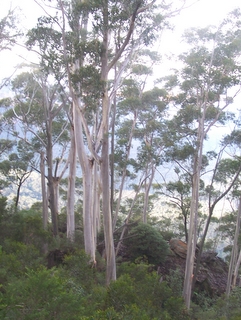Blue Mountains ash facts for kids
Quick facts for kids Blue Mountains ash |
|
|---|---|
 |
|
| The Blue Mountains ash tree in Katoomba, Australia. | |
| Scientific classification | |
| Genus: |
Eucalyptus
|
| Species: |
oreades
|
| Synonyms | |
|
|
The Eucalyptus oreades, often called the Blue Mountains ash, white ash, or smooth-barked mountain ash, is a medium to tall tree found in eastern Australia. It has smooth, white bark that looks like powder. Near its base, the bark is rougher. Its leaves are shaped like spears or are slightly curved. Its flower buds grow in groups of seven, and its flowers are white. The fruit looks like a cup or a cylinder.
Contents
About the Blue Mountains Ash
The Blue Mountains ash is a tree that usually grows up to 40 m (130 ft) tall. Its trunk can be as wide as 1.8 m (5 ft 11 in) across at chest height. This tree does not have a special woody swelling at its base called a lignotuber.
Bark and Leaves
The bark of this tree is smooth and can be white or yellow. It peels off in long strips, leaving a "skirt" of thicker bark up to 4 m (13 ft) high around the bottom of the trunk.
Young trees and new shoots have oval or egg-shaped leaves. These leaves are a dull grayish-green on both sides. They are about 80–200 mm (3.1–7.9 in) long and 35–100 mm (1.4–3.9 in) wide.
Adult leaves are shiny green on both sides. They are shaped like a spear or are slightly curved. These leaves are about 75–180 mm (3.0–7.1 in) long and 10–32 mm (0.39–1.26 in) wide. They grow on a leaf stalk, called a petiole, which is about 10–22 mm (0.39–0.87 in) long.
Flowers and Fruit
The flower buds grow in groups of seven where the leaves meet the stem. They are on a slightly flat stalk called a peduncle, which is 15–25 mm (0.59–0.98 in) long. Each bud has a small stem, or pedicel, about 2–5 mm (0.079–0.197 in) long.
When the buds are ready, they look like diamonds or spindles. They are about 5 mm (0.20 in) long and 3–4 mm (0.12–0.16 in) wide. They have a cone-shaped or beaked cap called an operculum.
The Blue Mountains ash flowers from January to March. Its flowers are white. After flowering, the tree produces a woody fruit. This fruit is a capsule that looks like a cup, urn, or cylinder. It is about 5–10 mm (0.20–0.39 in) long and 6–10 mm (0.24–0.39 in) wide.
How it Got its Name
The Eucalyptus oreades was officially described in 1900 by Richard Thomas Baker. He wrote about it in a scientific paper after collecting samples near Lawson in the Blue Mountains.
The name oreades comes from the Greek word for "Oreades." These were mountain nymphs in Greek myths. This name was chosen because the tree often grows in mountainous areas.
Where the Tree Grows
The Blue Mountains ash grows in eastern Australia. You can find it from Mittagong in the Southern Highlands up to Binna Burra and Springbrook in south-eastern Queensland. It is very common in the Blue Mountains.
Preferred Environment
This tree likes to grow in sandstone soils in the Blue Mountains. In other areas, it grows in red clay soils. In the Blue Mountains, it is found on steep slopes and ridges. It prefers south or east-facing slopes. It grows at heights from 600 to 1,200 metres (2,000 to 3,900 ft) above sea level. The areas where it grows usually get 900 to 1,400 millimetres (35 to 55 in) of rain each year.
Forest Friends
The Blue Mountains ash grows in open eucalypt forests. Other trees that often grow nearby include:
- Silvertop ash (E. sieberi)
- Narrow-leaved peppermint (E. radiata)
- Broad-leaved peppermint (E. dives)
- Sydney peppermint (E. piperita)
- Blaxland's stringybark (E. blaxlandii)
- Snappy gum (E. racemosa)
- Messmate stringybark (E. obliqua)
- Tallowwood (E. microcorys)
- New England blackbutt (E. andrewsii)
How it Survives in Nature
The Blue Mountains ash is special because it does not have a lignotuber. This means it is sensitive to bushfires. If a big fire happens, the tree often dies. However, new trees can grow from the seeds stored in the tree's top branches, called the canopy seedbank.
Older trees, more than 20 years old, have a skirt of thicker, corky bark at their base. This helps them survive smaller, less intense fires.
Uses of the Tree
The Blue Mountains ash grows very quickly when planted. Because of this, it is grown in special tree farms, called plantations, for its timber. This happens in Australia and also in other countries like New Zealand and South Africa.
Gallery
-
Eucalyptus oreades at Narrow Neck, Katoomba
-
Eucalyptus oreades trunk at Katoomba
-
Blue Mountains Ash on Mount Banda Banda
See also
 In Spanish: Eucalyptus oreades para niños
In Spanish: Eucalyptus oreades para niños




